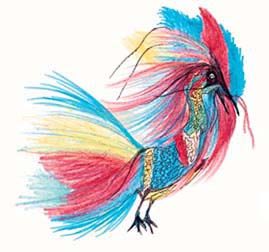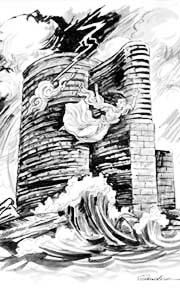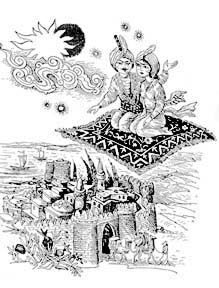|
Autumn 1998 (6.3)
Making Sense of Azerbaijan's Legends by Tahir Talibli, Ahmad Oghuz
and Jala Garibova
One woman, securing her baby on her back, joined a group of neighbors running swiftly and silently into the nearby woods. Suddenly, the baby started to cry. What could the mother do? The baby's wails would certainly give away their location and attract the bullets. The woman tried to muffle the child's cries, but the baby would not be quieted. In desperation, the mother finally strangled the child, sacrificing her own infant in order to save her neighbors, their children and herself. Heartbroken, the mother wept silently as she continued running with the weight of the dead child on her back. Several hours later, a miracle seemed to happen. She felt a slight stir - it was the baby, somehow, trying to revive. The incident is true. Memories are still fresh about the horror that the townspeople of Khojaly experienced less than seven years ago on February 25, 1992. It was a night they will never forget - a night that changed their lives forever. Azerbaijanis living in this mountainous region of Nagorno Karabakh were suddenly attacked by Armenian units commandeering the 366th Tank Regiment. The town with its population of approximately 8,000 people was obliterated in a single night. Several hundred people were murdered. No one knows the exact figure because the territory came under control of the invader and has remained that way ever since. The others fled. But the child somehow regained consciousness and is alive and well today. She now lives in Baku and has started school. She was recently featured on Azerbaijani television as the "Miracle Child from Khojaly."
One-eyed monster, Tapagoz, like Cyclops in Greek mythology. Artist: Nusrat. But the story of this woman who dared to sacrifice her own daughter for the greater good of the group is likely to live on for many years. It's a very familiar motif in Azerbaijani legends. As time goes by, such a story may end up in the repertoire of legends. If such were to happen, undoubtedly, the facts would eventually blur. Certain elements would become embellished and exaggerated; other elements, completely forgotten. Inevitably, the dates, places and names might end up confused or totally lost with the retelling, but the essence of the brave woman is likely to become even more elaborated. Such stories serve to inject a sense of fairness and justice in the lives of ordinary people. It's one of the primary reasons why legends are created in the first place and retold over and over for centuries and millennia. Legends enable people to resolve their problems in narrative form and to make sense of chaos even when it's impossible to do so in real life. In Azerbaijani legends, the image of the "div" or devil always represents the enemy. And in all the legends, the "div" is always defeated by a super hero - a human being. The same is not necessarily true in real life, it seems. Legends help create a sense of justice - a rational relationship between cause and effect. Heroes and heroines become rays of confidence and belief within a society, rescuing from danger, and providing a blueprint for behavior that is deemed acceptable by the group.
Flying Objects The flying carpet is also a legendary source of escape and fantasy. Often, if the hero needs to travel a long distance, a flying carpet would appear and take him. Or, if the hero is captured, a flying carpet will rescue him. Another important motif in Azerbaijani legends is that carpets can "talk": not in human speech, but through their patterns. In one story a king was saved by his own skill at carpet weaving. Kidnapped, he wove a carpet which merchants carried from country to country until his wife chanced to see it, deciphered the message in the symbols, and arranged for his rescue. Historical Value Morals For example, the flight of cranes is considered sacred because it is so precise and beautiful to watch. To interfere with its symmetry is considered a great wrong-doing. One legend tells of a mischievous boy who threw stones at a flight of cranes although his grandmother had warned against it. That night, their house was destroyed by a flood. Another legend admonishes one to keep commitments. A shepherd once promised God that he would sacrifice 40 sheep if he could reach the top of a peak on Shahdagh mountain. He conquered the mountain but later failed to keep his promise. Today, people point to the rock formations up there, claiming it is the shepherd with his sheep that God turned into stone because the shepherd did not keep his word. Origins Lala was a beautiful, rich girl who became a poppy (the Azeri word for poppy is "lala"). The black shading in the center of the flower is supposedly the blood from the girl's broken heart because she could not marry a poor boy whom she loved. Or there's the story of the girl with ugly legs who was transformed into a beautiful peacock. Or the girl who became a rose and her father the thorns on the stem. Her young lover became a nightingale who was pricked by the thorns whenever he tried to approach the flower. The bird's blood dripped down upon the rose, making it red. In the Azeri language, a rose is called "gizilgul" which means "red flower." The treasury of legends in Azerbaijan is endless. There are many themes and motifs, many purposes that they serve. But for the keen observer, they reveal many of the characteristic features of our nation, providing clues about values and patterns that are indigenous to our community. Tahir Talibli and Ahmad Oghuz
are folklorists from the State Radio Company's Folklore Department.
The Folklore Department was created to propagate Azerbaijani
folklore and spread it among the people. Their programs feature
stories and samples of folk music, as well as information about
ashugs, folk traditions and tales, ceremonies and holidays. Jala
Garibova is a staff researcher in Baku. Back to Index
AI 6.3 (Autumn 1998) |
||||


 Creating Legends
Creating Legends
